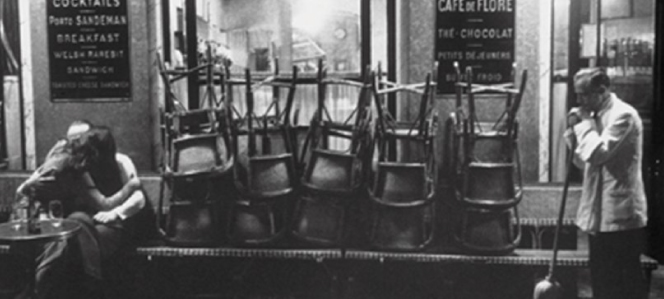The true mystery of the world is the visible, not the invisible.
— Oscar Wilde
Recently, I was driving with two of my brothers from New England to New York, and we all got to talking about religion. One gladly played up his own skepticism: isn’t it suspicious, he said, that every faith claims to be the “one true church”? Wasn’t this mentality (“OTC” we call it now) the stuff of gangs, clubs, and nation states, the same myopic “us vs. them” mentality one sees everywhere in the world, only now in the spiritual realm? Isn’t it more likely true that all of them are somehow right—or better yet, none at all?
But this contentious conversation gradually morphed into another one entirely, and as I-95 flew past us, the polemics gave way to an honest admission. In peak moments, my brother said, he felt himself whisked into a primitive wonder: Why all of this—my life, the world, this whole universe? Why anything at all? He confessed that his mind rushed back down to everyday worries, and that he felt there was no way to answer such a question. But did we understand that terrible awe? We nodded—we knew exactly what he meant.
 For Leibniz, the question was this: Why is there something rather than nothing? William James once called this the “darkest question in all of philosophy,” which is perhaps why so many 20th century thinkers were anxious to squelch it. Although Heidegger gave the meaning of Being center stage, logical positivists like A.J. Ayer increasingly dismissed the question as an exercise in futility, rooted in metaphysical claptrap. “That’s a perfectly meaningful question as regards any given event,” Ayer said, “but if you generalize that question, it becomes meaningless.” Yet as logical positivism faded in the 60s, and exciting discoveries in physics and cosmology changed the intellectual landscape, there have been renewed attempts to finally answer the question.
For Leibniz, the question was this: Why is there something rather than nothing? William James once called this the “darkest question in all of philosophy,” which is perhaps why so many 20th century thinkers were anxious to squelch it. Although Heidegger gave the meaning of Being center stage, logical positivists like A.J. Ayer increasingly dismissed the question as an exercise in futility, rooted in metaphysical claptrap. “That’s a perfectly meaningful question as regards any given event,” Ayer said, “but if you generalize that question, it becomes meaningless.” Yet as logical positivism faded in the 60s, and exciting discoveries in physics and cosmology changed the intellectual landscape, there have been renewed attempts to finally answer the question.
Recently, longtime New Yorker contributor Jim Holt released Why Does the World Exist? An Existential Detective Story, which introduces the leading theories today. After a “brief history of nothing,” Holt concludes that it is rather striking that Nothing (or the “Null World”) shouldn’t be the case. Nothing is “the simplest theory of all” with “zero arbitrary features,” and is the only cosmic possibility “that does not stand in need of a causal explanation.” Being seems to be, as one writer put it, a sort of “blot on nothingness.” According to Holt:
“Absent any data about reality the Null World is the one that should be expected to obtain. But it does not obtain! There is evidently a great abundance of Being. If we are scientifically minded, this should surprise us—shouldn’t it?”
Holt then undergoes a cosmological quest across the globe, where he meets with leading scientists, philosophers, and writers, all of whom give their own take on why the world exists.
What are their answers, and which one is the most convincing? Let’s explore each of them.
1: Who Cares?

Adolf Grünbaum
Holt first travels to the University of Pittsburgh to speak with Adolf Grünbaum, “arguably the greatest living philosopher of science.” Grünbaum, “the great rejectionist,” believes—like Ayer before him—that “there can’t be a reason for the world’s existence, and hence that the very question is meaningless.”
As far as Grünbaum can tell, the Christian account of creation ex nihilo (“out of nothing”), and a “dependency axiom” (which makes God the sustainer of the universe), spawned belief in the spontaneity of Nothing, which prompts a wild goose chase of existential searching. According to Grünbaum, even atheists like Dawkins unwittingly imbibe this religious garbage “with their mother’s milk.” “Go relax and enjoy yourself!” Grünbaum instructs Holt. “Don’t worry about why there’s a world—it’s an ill-conceived question!”
But Holt finds something precarious in Grünbaum’s argument, and indeed in his visit with the man, which climaxes with a near car-wreck and transition “from Pittsburgh to Nothingness.” His hostile waving off of “the primordial existential question” strikes Holt as “premature intellectual closure,” a rash dismissal of both the simplicity of Nothing and the principle of sufficient reason. Moreover, most atheists who explicitly reject faith are not as unastonished about the universe as Grünbaum is; the question is human, all too human, not Christian, all too Christian. “The mystery of existence,” Holt concludes, “was still out there.”
2: God the Whine Stopper
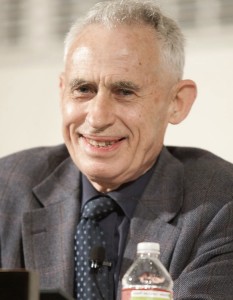
Richard Swinburne
At one point, Holt recounts how someone once asked Sidney Morgenbesser why there was something rather than nothing; to which Morgenbesser replied, “Oh, even if there was nothing, you still wouldn’t be satisfied!” The joke reminds us that the human longing (some might say “whining”) for a final explanation runs deep. With this in mind, Richard Swinburne—Holt’s second interlocutor—gives us a great “whine stopper.”
Swinburne contends that “the simplest hypothesis explaining it all is the one that posits God.” As they talk, Holt notes Swinburne’s emphasis on simplicity. “Where other philosophical theists talked of necessity, he talked of simplicity; and simplicity, as he saw it, made a hypothesis only probable, not undeniably certain.” God, the infinite ground of our finite world, is the simplest and most coherent “stopping point” of explanation.
Swinburne’s God, Holt admits, “does possess a certain sort of simplicity,” even if his belief in Christ strikes Holt as superfluous in contrast with deism. (Holt is a committed atheist, even though he finds the writings of the new atheists ‘sloppy.’) In the end, though, it’s not enough for Holt’s hungry mind. Swinburne calls God a “brute fact,” and admits that a final explanation of the existence of God—who he sees as within time—is above his pay grade. “It’s not merely that there is no explanation for God’s existence,” he says. “There couldn’t be an explanation.” Swinburne, Holt laments, “seems to have solved one mystery at the price of introducing another,” and in the next chapter, he tears apart (as Aquinas had done centuries before) what he sees as a necessary support for Swinburne’s God: the ontological argument.
3: Multiverse

David Deutsch
Holt then travels to Headington (where J.R.R. Tolkien made his home) to meet with David Deutsch, “widely regarded as one of the most daring and versatile scientific thinkers alive.” Deutsch’s view of the world “encompassed a huge ensemble of worlds, all existing in parallel: a multiverse. The multiverse was for Deutsch what God had been for Swinburne: it was the simplest hypothesis that explained what we observed around us—notably, the weird phenomena of quantum mechanics.”
Like Swinburne’s God, though, Deutsch does not believe that the multiverse can finally be explained. “I don’t think we’ll find a brick wall that says, ‘this is the ultimate explanation for everything.'” Why, Holt wonders, does the multiverse exist, if the multiverse is the answer to why the world exists? “That question,” Deutsch says, “could only be answered by finding a more encompassing fabric of which the physical multiverse was a part. But there is no ultimate answer.”
Holt leaves with one positive impression: “that there is a lot more to reality than we might imagine.” Still, he finds Deutsch’s answer insufficient. “When it comes to understanding reality, David Deutsch turned out to be something of a ‘turtles all the way down’ man…there is no bedrock principle that explains absolutely everything (including the principle itself).”
4: Quantum Craziness
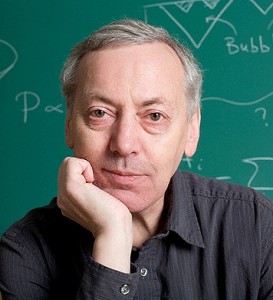
Alex Vilenkin
The next thinker Holt speaks with is Alex Vilenkin, a leading physicist and cosmologist at Tufts. Here, we notice an empirical turn in Holt’s investigation: can science alone account for why the world exists? Neil DeGrasse Tyson, in a review of Lawrence Krauss’ book A Universe From Nothing, writes: “Nothing is not nothing. Nothing is something. That’s how a cosmos can be spawned from the void.”
But as theists like to point out, this is an evasion, or at least a misunderstanding, of the problem Holt is grappling with. Deutsch admits as much a few pages earlier: “The quantum vacuum is a highly structured thing that obeys deep and complex laws of physics,” he says. “It’s not ‘nothingness’ in the philosophical sense at all.'” Scientists are, like all of us, tasked with pulling the rabbit of Being out of the hat of Nothing.
Vilenkin, Holt writes, has brought quantum theory close to accomplishing this, showing that, out of “an initial state of nothingness, a tiny bit of energy-filled vacuum could spontaneously ‘tunnel’ into existence.” This is stage one: from nothingness to a quantum vacuum. In the second stage, the vacuum “blows up into a matter-filled precursor of the universe we see around us today”—the Big Bang!
Yet, Holt is completely unconvinced. “Surely,” he writes, “the bubble of false vacuum out of which the cosmos was born had to come from somewhere.” And what about the ontological “clout” of the laws of physics? In what are they grounded? “If you like,” Vilenkin responds, “you can say they’re in the mind of God.” This tongue-in-cheek return to theism leaves Holt disappointed, and he concludes, with Deutsch, that quantum theory is “too parochial to address the question of existence.” Instead, he looks toward a more robust scientific explanation: the final theory.
5: A Final Theory?
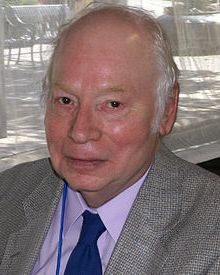
Stephen Weinberg
After Vilenkin, Holt meets with Stephen Weinberg, a Nobel Prize-winning physicist and author of Dreams of a Final Theory. (Weinberg, incidentally, has also “inveighed against religion,” but admitted that he didn’t think “science could ever explain the existence of moral truths.”)
First, Weinberg confirms Holt’s rejection of the last answer. “Quantum mechanics by itself does not say anything about the universe spontaneously coming into existence,” he says. “For that sort of thing, you need quantum mechanics with other theories married to it.” For Weinberg, this is the purview of the “final theory,” which would “tie up all the forces of nature—including gravity—into a single neat mathematical package.” Weinberg also invokes Nozick’s principle of fecundity, noting that it has a “certain pleasing self-consistency.”
But Holt is skeptical about Weinberg’s final theory, partly because Weinberg himself exhibits a sort of “epistemic modesty” about it. “I think we’re permanently doomed to that sense of mystery,” Weinberg admits. “And I don’t think belief in God helps.” Holt leaves their meeting convinced that “the question Why is there something rather than nothing? lies outside the ambit of even the final theory.” Or, as Allan Sandage, the father of modern astronomy, once said: “As soon as you ask why there is something instead of nothing, you have gone beyond science.”
6: Penrose Platonism
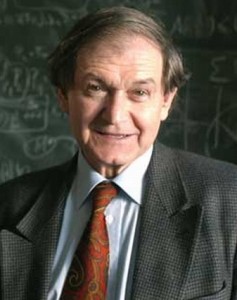
Sir Roger Penrose
But to whom shall we go? For the tough-minded Holt, another serious contender is the mathematical Platonism of Sir Roger Penrose, Professor of Mathematics at Oxford and co-creator of “impossible objects” like the Penrose stairs. For Penrose and the Platonists, “the objects contemplated by mathematicians must exist in another world, one that is eternal and transcendent.” They “believe in a kind of heaven—not a heaven of angels and saints, but one inhabited by the perfect and timeless objects they study.”
Penrose offers Holt an elegant account of “the three worlds” of Being, which provides a stirring sense of “moreness” that materialist accounts of the world tend to lack. “Each of the three worlds—the physical world, the world of consciousness, and the Platonic world—emerges out of a tiny bit of one of the others,” Penrose explains. “And it’s always the most perfect bit.” Thus, the brain gets us from matter to consciousness, and mathematical truth gets us from consciousness to a non-religious heaven of pure Forms.
Although Holt is impressed, he doesn’t buy it. “Through this self-contained causal loop…the three worlds mutually support one another, hovering in midair over the abyss of Nothingness, like one of Penrose’s impossible objects.” And how could an abstract realm reach out cast concrete “shadows”—matter and consciousness? Sir Roger conceded that it was a “mystery.” Other Platonists, however, were not so easily defeated—they believed that it was logically necessary that the Good should result in Being.
7: Value Rules!

John Leslie
Could it be an “ethical requirement” that the messiness of Being should overcome the simplicity of Nothing? This is the answer of Canadian cosmologist and philosopher of science John Leslie, who—although he eschews traditional religious notions of God—has written a book called Immortality Defended that looks at the possibility of eternal existence through quantum entanglement.
Leslie’s Platonism, which sees existence as essentially mental (his “grand vision” consists of an infinite number of infinite minds), is rooted in a key phrase of The Republic: the Good is what “bestows existence upon things.”
“Goodness is required existence, in a nontrivial sense,” Leslie explains. But how, Holt wonders, does he square his “goodness of Being” with the overabundance of evil and suffering in the world? Isn’t a vacuum, as Tennessee Williams once quipped, “a hell of a lot better than some of the stuff nature replaces it with”? Leslie replies:
“Our universe is just one of the structures that an infinite mind would contemplate. It would also know the structure of infinitely many other universes. And it would be very unlikely for ours to be the best of all of them.”
But Holt is unswayed by Leslie’s axiarchism (“value rules”). (In fact, Leslie himself seems rather tentative, admitting that his confidence in his own theory is “just a little over 50 percent.”) He cites Oxford philosopher (and atheist) J.L. Mackie, who doubted that “something’s being valuable can in itself tend to bring that thing into existence”—that “objective ethical requiredness” can reach out and create a world. Holt agrees: “reasons without agents are impotent.” His “hunger for ultimate explanation” rages on.
8: Come Down, Selector

Derek Parfit
The closest that Holt comes to feeling that the question has been answered is with the English philosopher Derek Parfit. Parfit, another Oxford professor, does what any good philosopher does: clears away all the clutter and confusion, and goes back to the drawing board.
For Parfit, there are a full range of cosmic possibilities, from the null world (or Nothing) to all worlds, and each possibility possesses a special feature (e.g., Simplicity for the null world, or Fullness for all worlds). For Parfit, the world that prevails does so because of this feature, which he calls “the Selector.” Above this feature there is a “meta-Selector,” which selects the Selector. But a meta-Selector cannot select the same Selector, “on pain of circularity.” Given this framework, Holt concludes with Parfit: “If Simplicity rules at the meta-explanatory level, it would not pick itself as the Selector at the explanatory level. Rather, it would decree that there would be no Selector at all.” With no Selector, we should not expect Nothing to triumph—the odds are too low. Instead, we should expect Being to be one of many “generic possibilities”—in a word, random.
After their meeting, Holt writes a letter to Parfit, expounding on the theory. Holt reasons that only Simplicity and Fullness could be meta-Selectors, because they don’t select themselves as Selectors. As described above, Simplicity would pick the “null” Selector (meaning no Selector at all), resulting in a random cosmic possibility, and Fullness would pick partial Selectors (otherwise there would be both Nothingness and Being, which is a contradiction), resulting in a mediocre cosmic possibility. Holt concludes that our world is either a random or mediocre “cosmic meaninglessness,” born of the only possible two meta-Selectors—Simplicity or Fullness. This explains why there is something rather than nothing.
But does it? Setting aside the conspicuous unsuitability of words like “random” and “mediocre” to describe our universe, Holt seems convinced that “meta-Selectors” don’t violate the principle of sufficient reason—that they are not the “brute facts” he has been avoiding. But it’s worth revisiting his words on an earlier page:
“You need a Selector…then you need a meta-Selector…then you need a meta-meta-Selector…Could this explanatory regress ever come to an end? And if so, how could it end? With some highest selector? Then wouldn’t that be the ultimate brute fact? When I put this question to Parfit, he conceded that the quest to explain reality would likely end with such a brute fact.”
It seems this is just what Holt has done: dressed up a naked brute fact (the meta-Selector) in the finery of finality. But the “principle itself” is not explained! In fact, it strikes the thoughtful reader as a kind of ruse to bypass the Selector of Simplicity, which is biased toward Nothing.
We are also reminded of Holt’s own criticism of Leslie: how can an abstract Selector reach out and realize a concrete world any more than an abstract “ethical requirement”? Whence its “clout”? And what of the “partial” Selector, which makes a partial meta-Selector conceivable, exploding the entire delicate framework?
Holt does not address these weaknesses—but judging by the fact that he continues on with the book, he is far from satisfied with his own best answer.
9: Light Verse

John Updike
Holt then meets with the novelist John Updike (Rabbit, Run). Updike, he notes, seemed to be “fortified” by a Kierkegaardian “leap-of-faith version of Christianity” which dispenses with natural theology in favor of a kind of fideism. (“This is a faith,” Updike says, describing the writings of Karl Barth. “Take it or leave it.”)
As for the question of Being, Updike holds out as little hope for science as he does for theology. “Science aspires, like theology used to, to explain absolutely everything,” he says. “But how can you cross this enormous gulf between nothing and something?” Citing Aquinas, he considers the notion that “God made the world ‘in play’…that makes reality seem almost a piece of light verse.” Within a year after their conversation, Updike died of lung cancer.
Although it’s clear that Holt enjoys their chat immensely, and admires Updike’s levity if not his faith, his mind remains restless; he is off to the races in the next chapter in a full-blown fit of Cartesian skepticism. Although this digression marks the official end of his investigation, his last chapter—”Return to Nothingness”—unintentionally introduces another theory.
Love Alone Is Credible
In the midst of writing this book, Holt suddenly receives news that his mother—a devout Catholic who attended daily mass—is dying. He travels back to his home state of Virginia to be with her in her last days, and the following scene transpires as he sits by her bedside:
“I was alone with her. I put my hand on her brow. I gave her a kiss on the cheek. She was breathing steadily, and her facial muscles looked relaxed—no sign of pain. I sang a corny song called “True Love” that she and my father used to sing to each other in harmony, amid gales of laughter. I talked about trips we had taken together as a family many years ago. Not the slightest response. I looked out the french doors of her room at the summer flowers outside, the birds, the butterflies. Such a sweet scene…Then, as I was standing directly over her, still holding her hand, my mother’s eyes opened wide, as if in alarm. It was the first time I had seen them that day. She seemed to be looking at me. She opened her mouth. I saw her tongue twitch two or three times. Was she trying to say something? Within a couple of seconds, her breathing stopped. I leaned down and whispered that I loved her. Then I went into the hall and said to the nurse, “I think she just died.”
That night, he goes out to dinner, glibly informs the bartender that his mother has just died, and polishes off a bottle of wine. He then walks to the highest hill in his hometown and breaks into “convulsive sobs.”
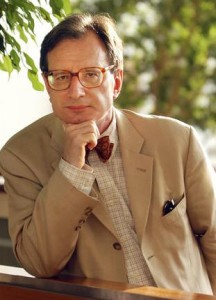
Jean-Luc Marion
This last chapter reminded me of the work of Jean-Luc Marion, the Director of Philosophy at the Sorbonne and former student of Jacques Derrida (and who at least one reviewer suggested that Holt should have interviewed). Marion works in the tradition of phenomenology, which takes the “appearances of things” to be the starting point for philosophy, rather than metaphysics or epistemology. This gives Marion an interesting perspective on the question of Being; he starts not with grand concepts like God, the multiverse, or Platonic realms, but with immediate conscious experiences. He also offers us something of a “final theory” which combines the others: like Grünbaum he deems the primal metaphysical question to be somewhat ill-conceived; like Penrose and Leslie, he emphasizes human consciousness; and like Swinburne and Updike, he references Aquinas and untangles the theological implications of his work.
In Being Given, Marion’s rigorous treatise on phenomenology, he goes beyond Husserl’s reduction to objectness and Heidegger’s reduction to beingness toward a more radical reduction: givenness. For Marion, the key to phenomenology—and something that Husserl and Heidegger hinted at without untangling—is that “what shows itself first gives itself.” The paradigm of what shows itself is the saturated phenomenon, an excess of intuition that arises on the screen of consciousness, floods intentionality, and renders the thinking subject a “witness,” or “the gifted.”
Holt’s witnessing of his mother’s death is a profound example of Marion’s saturated phenomenon—all the more so because it follows a discourse on the Cartesian ego. It meets all of Marion’s descriptions of saturation: it explodes the Kantian categories as unforseeable, unbearable, absolute, and irregardable event; it dramatically inverts metaphysical hierarchies of cause and effect, substance and accident, and necessity and contingency; and it stuns and overwhelms the elaborate abstract constructions of the rational ego with its own immediate, pressing givenness.
But most fascinating, it has so much to do with love. Holt kisses his mother, sings her a song called “True Love,” takes notice of the “sweet scene” outside, and whispers “I love you” just before she passes. For Marion, love, like givenness, is “beyond being,” and is the key response to the anonymous “call” of a saturated phenomenon—indeed, it is the secret to understanding why there are phenomena at all.
Lessons
I think there are two great lessons to take way from Holt’s book.
The first is that reports of the death of philosophy have been greatly exaggerated. Holt shows that philosophy is a timeless and necessary pursuit. Indeed, as many of these thinkers affirm, only philosophy is equipped to go places that the natural sciences must pass over in silence.
The second lesson is that Christianity gives us neither impenetrable obscurity nor cut-and-dried explanation; it is amenable to reason but not totally subject to it. “We shall not cease from exploration”…but “we see now through a glass darkly.” Out of all of the philosophical theories that Holt entertains, Swinburne’s strikes me not only as the simplest, but as the best; it explains the largest chunk of reality and leaves us with the fewest assumptions. Still, Holt rejects God because he cannot fully understand who or why God is. Philosophically, I think this is a mere miscalculation; but theologically, it’s a great misconception. As Marion argues, and as Holt’s own account of his mother’s death reveals, the knowledge of love—an image of the same love “that moves the sun and other stars”—must finally go beyond what analytic knowledge can subdue. Love’s logic transcends formal logic—it even, in Marion’s framework, transcends Being—and total love, not total explanation, is what Christianity is finally about.
